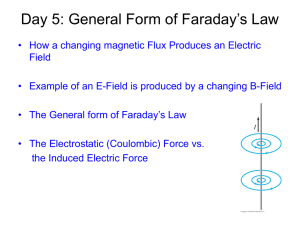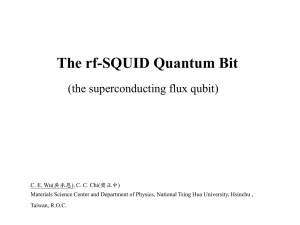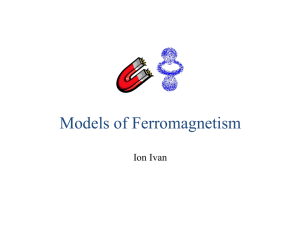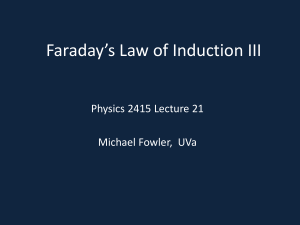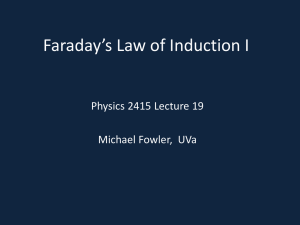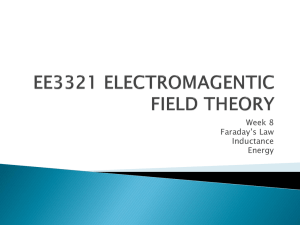lecture13
advertisement
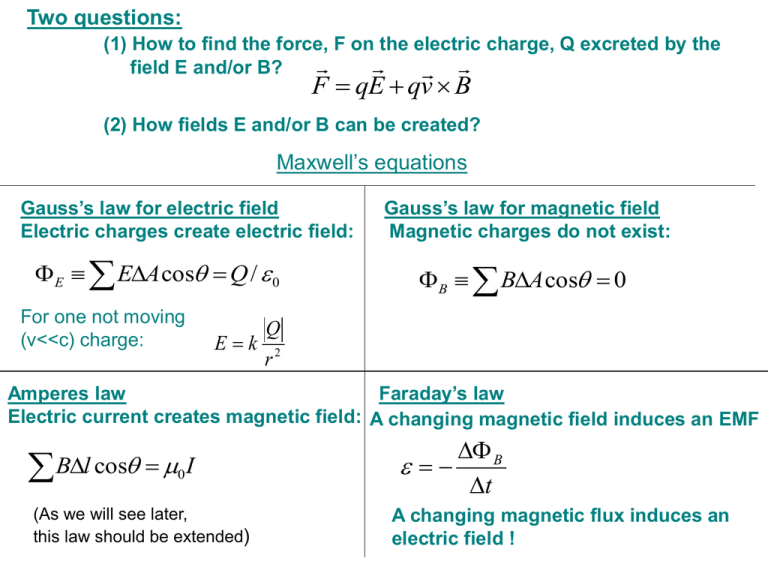
Two questions: (1) How to find the force, F on the electric charge, Q excreted by the field E and/or B? F qE qv B (2) How fields E and/or B can be created? Maxwell’s equations Gauss’s law for electric field Electric charges create electric field: E EA cos Q / 0 For one not moving (v<<c) charge: Ek Gauss’s law for magnetic field Magnetic charges do not exist: B BA cos 0 Q r2 Amperes law Faraday’s law Electric current creates magnetic field: A changing magnetic field induces an EMF Bl cos 0 I (As we will see later, this law should be extended) B t A changing magnetic flux induces an electric field ! 8. Electromagnetic induction (Faraday’s law) 1) Flux (review) B BA cos B BA cos Units: (weber) 2) EMF (review) W Fl cos q q El cos [ΦB] = 1 Wb = 1 T·m2 3) Faraday’s law B t El cos BAcos t A changing magnetic flux induces an EMF For N loops: N N 1 BAcos t A changing magnetic flux induces an electric field ! This electric field is not a potential field. The field lines form a closed loops. 4) Lenz’s law The direction of any magnetic induction effect is such as to oppose the cause of the effect For instance: a current produced by an induced emf moves in a direction so that its magnetic field opposes the original change in flux v S N I B v S N I B v N S I B v N S B I Example: If a North pole moves toward the loop in the plane of the page, in what direction is the induced current? Since the magnet is moving parallel to the loop, there is no magnetic flux through the loop. Thus the induced current is zero. Example: In order to change the magnetic flux through the loop, what would you have to do? 1) 2) 3) 4) 5) drop the magnet move the magnet upwards move the magnet sideways all of the above only (1) and (2) Moving the magnet in any direction would change the magnetic field through the loop and thus the magnetic flux. 1) 2) 3) 4) 5) tilt the loop change the loop area use thicker wires all of the above only (1) and (2) Since, B BAcos changing the area or tilting the loop (which varies the projected area) would change the magnetic flux through the loop. Example: Wire #1 (length L) forms a one-turn loop, and a bar magnet is dropped through. Wire #2 (length 2L) forms a two-turn loop, and the same magnet is dropped through. Compare the magnitude of the induced currents in these two cases. 1) 2) 3) 4) I1 I1 I1 I1 > < = = I2 I2 I2 0 I2 = 0 B B1 N t t S N S N Induced emf is twice as large in the wire with 2 loops. The current is given by Ohm’s law: I = V/R. Since wire #2 is twice as long as wire #1, it has twice the resistance, so the current in both wires is the same. Example: A bar magnet is held above the floor and dropped. In 1, there is nothing between the magnet and the floor. In 2, the magnet falls through a copper loop. How will the magnet in case 2 fall in comparison to case 1? 1) it will fall slower; 2) it will fall faster; 3) it will fall the same When the magnet is falling from above the loop in 2, the induced current will produce a North pole on top of the loop, which repels the magnet. When the magnet is below the loop, the induced current will produce a North pole on the bottom of the loop, which attracts the South pole of the magnet. S N S N Example 1: A coil of 600 turns with area 100 cm2 is pleased in a uniform magnetic field. The angle between the direction of the field and perpendicular to the loop is 60°. The field changes at a rate of 0.010 T/s. What is the magnitude of the induced emf in the coil? N 600 B BA cos NBA cos 60 B B N A cos t t A 100cm2 B 0.010T / s t ? B B N A cos t t 600 0.010T / s 10010 4 m 2 cos60 0.03V B BA cos NBA cos Example 2: B A NB cos t t N 600 60 A 100cm2 / s t B 0.010T ? B A NB cos t t 600 0.010T 10010 4 m 2 / s cos60 0.03V Example 3: A 12.0-cm-diameter wire coil is initially oriented perpendicular to a 1.5 T magnetic field. The loop is rotated so that its plane is parallel to the field direction in 0.20 s. What is the average induced emf in the loop? N 1 f 0 in 90 2 r 12.0cm A r 2 B 1.5T t 0.20s ? B BA cos B Bf Bin BA cos0 cos90 BA B BA t t 2 1.5T 0.12m / 2 0.20s 8.5 10 2 V 8a. Applications of Faraday’s law 1) Rotating loop: t 2 2f T I B B BA cos BA cost B BA cost cost BA t t t I BA sin t Example: N 200 max NBA B 0.03T A 100cm 100s 1 max ? 2 max 200 0.03T 100104 m 2 100s 1 6V Example: A generator rotates at 85 Hz in a magnetic field of 0.03 T. It has 1000 turns and produces an rms voltage of 150 V . What is the area of each turn of the coil? f 85Hz B 0.03T N 1000 rms 150V A? max NBA max A NB max 2 rms 2f 2 rms A 2fNB 2 150V A 1.3 102 m 2 85Hz1000 0.03T max sin(t ) NBA sin(t ) max 0

